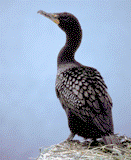United States Department of Agriculture, National Wildlife Research Center: Symposia

Symposium on Double-Crested Cormorants: Population Status and Management Issues in the Midwest
Date of this Version
December 1997
Abstract
The Michigan Department of Natural Resources, in conjunction with the University of Michigan and the U.S. Fish and Wildlife Service, initiated a research study to determine the impact of double-crested cormorants (Phalacrocorax auritus) on the yellow perch (Perca flavescens) population in the Les Cheneaux Islands area of northern Lake Huron. Aerial and nesting colony counts were conducted to monitor cormorant abundance. Creel census counts and tagging of 8,400 perch were used to study perch abundance. We collected 373 cormorants to study food habits via stomach-content analysis. We found that (1) cormorants fed heavily on yellow perch in early spring, but over the entire season only 10 percent of their diet was perch; (2) alewives (Alosa pseudoharengus) and sticklebacks (Culaea inconstans, Pungitius pungitius, Gasterosteus aculeatus) made up the major portion of the cormorants’ diet; (3) cormorants removed only 2.3 percent of the available perch biomass (v. 1.8 percent by anglers over the same period); (4) most fish taken by cormorants were less than 150 mm long; (5) total annual perch mortality was about 45 percent, of which less than 9 percent was due to cormorants; and (6) cormorants accounted for only 0.8 percent of the mortality of legal-size perch (≥178 mm), whereas summer sport fishing accounted for 2.5 percent. Thus, although the impact of cormorants on the perch population may vary slightly from year to year, we conclude that cormorant predation had minimal impact on the local perch population.

